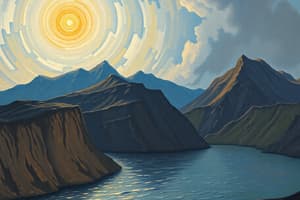Podcast
Questions and Answers
What describes the movement of tectonic plates atop the asthenosphere?
What describes the movement of tectonic plates atop the asthenosphere?
- The plates move independently of the convection currents.
- The plates remain stationary and do not interact with the asthenosphere.
- The plates move across the semi-solid asthenosphere due to convection currents. (correct)
- The plates move quickly at a speed of around 10 centimeters per year.
What is the main characteristic of a reverse fault?
What is the main characteristic of a reverse fault?
- Plates move away from each other.
- Two plates slide across each other violently.
- A rock mass moves downward relative to the other rock mass.
- A rock mass is pushed up relative to the other rock mass. (correct)
What type of wave can travel through solid, liquid, and gas?
What type of wave can travel through solid, liquid, and gas?
- Rayleigh waves
- P waves (correct)
- Love waves
- S waves
Which term refers to the flat surface revealed in the movement of a fault?
Which term refers to the flat surface revealed in the movement of a fault?
What describes the source of an earthquake?
What describes the source of an earthquake?
What is the primary motion of S waves?
What is the primary motion of S waves?
How does faulting occur?
How does faulting occur?
What is a common characteristic of body waves?
What is a common characteristic of body waves?
What describes the term 'ripple effect' in relation to earthquakes?
What describes the term 'ripple effect' in relation to earthquakes?
What is the main role of a seismologist?
What is the main role of a seismologist?
Flashcards are hidden until you start studying
Study Notes
Lithosphere
- The lithosphere consists of the Earth's crust and the uppermost part of the mantle.
- It is a rigid layer that floats on the semi-solid asthenosphere.
Tectonic Plates
- Tectonic plates are large sections of the Earth's lithosphere that move slowly across the asthenosphere due to convection currents.
- The rate of movement is approximately 1.6 centimeters (0.6 inches) per year.
Earthquakes
- Earthquakes are sudden movements or shaking of the Earth's crust caused by the release of energy from the movement of tectonic plates.
- The point where an earthquake originates is called the focus.
- The point on the Earth's surface directly above the focus is called the epicenter.
Faults
- Faults are fractures or cracks in the Earth's crust where movement has occurred.
- The hanging wall is the rock mass that is above the fault surface.
- The footwall is the rock mass below the fault surface.
- The fault plane/fault scar is the flat surface revealed by the movement of the fault.
- Strike refers to the horizontal line or crack formed on the surface of the plate.
Types of Faults
- Normal faults: Occur when one rock mass moves downward relative to the other.
- Transform faults: Occur when plates slide across each other, causing violent earthquakes.
- Reverse faults: Occur when one rock mass is pushed upward relative to the other.
- Divergent faults: Occur when plates move away from each other, relatively rare.
Earthquake Process
- Energy builds up over time due to tectonic plate movement.
- Energy is released, creating seismic waves that travel through rocks.
- Rocks move until the energy is used up.
Earthquake Waves
- Body Waves: Travel through the Earth's interior.
- P Waves (Primary Waves): Longitudinal waves that travel through solids, liquids, and gases.
- S Waves (Secondary Waves): Transverse waves that travel only through solids.
- Surface Waves: Travel along the Earth's surface.
- L Waves (Love Waves): Horizontal shearing motion.
- R Waves (Rayleigh Waves): "Rolling" motion.
Measuring Earthquakes
- Magnitude: Measures the energy released at the earthquake's source. Determined by seismographs.
- Intensity: Measures the strength of shaking at a specific location. Determined by effects on people, structures, and the environment.
- Richter Scale: Measures earthquake magnitude.
- Modified Mercalli Scale: Measures earthquake intensity.
Studying That Suits You
Use AI to generate personalized quizzes and flashcards to suit your learning preferences.




